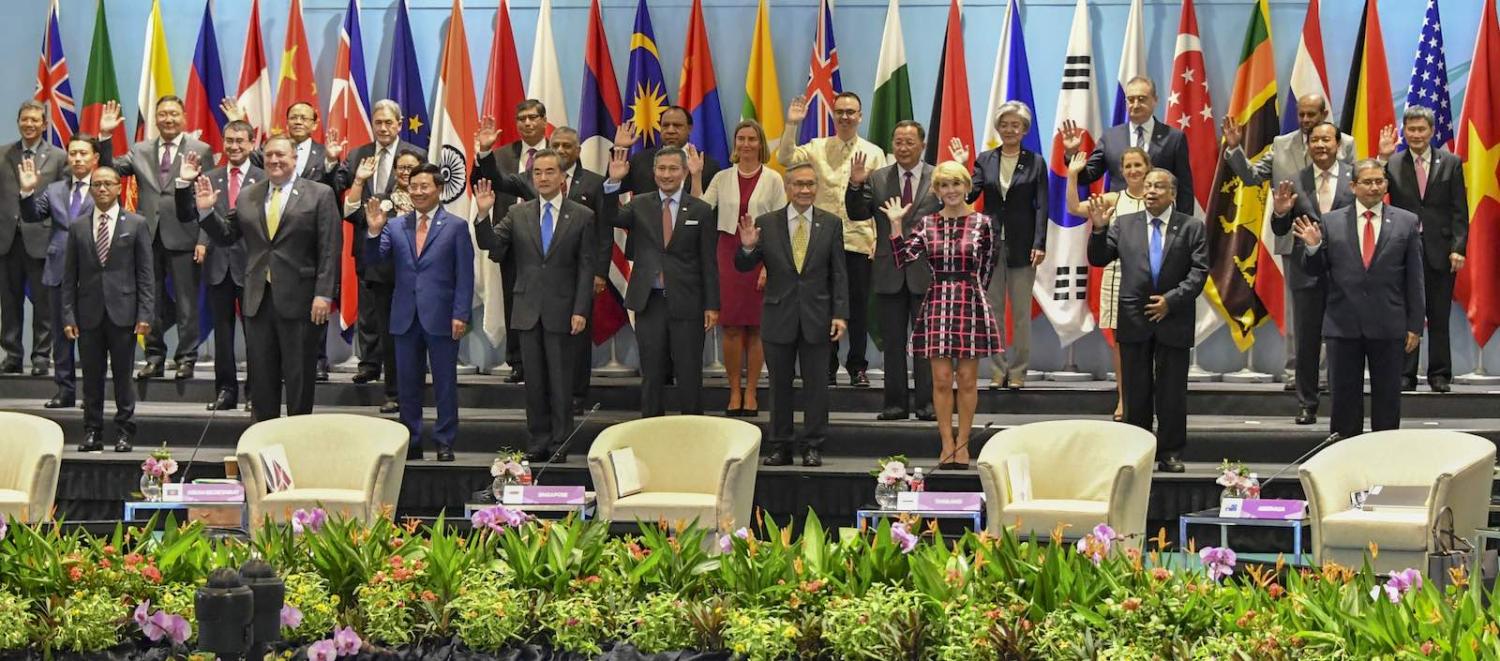The ASEAN Regional Forum (ARF) – with its unwieldy number of member states (27) and preoccupation with dialogue (a “talk shop”) – has been declared a failure time and again. Some criticism is justified. But it can also be argued that the earliest expectations regarding this regional institution were unrealistic. Also, in today’s complex and nervous Asian region, there are good reasons to acknowledge the ARF’s value – including its value to Australia – and to seek to strengthen its effectiveness.
As tedious as some ASEAN Regional Forum “talk-shop” meetings can be, they sustain the visibility of a range of security challenges.
The ARF, which first met in 1994, was the first multilateral process in East Asia dedicated to dealing with regional security. In establishing the forum, the Association of Southeast Asian Nations (ASEAN) was responding to opportunities and concerns generated by the end of the Cold War.
After several years of discussion and negotiation, the ARF was designed to centre on Foreign Ministers, and included key players from both sides of the former Iron Curtain. At the outset, the organisation launched a study of the principles that would guide the conduct of its meetings.
The resulting Concept Paper, however, was ambitious. Although stressing the vastness of East Asia, and the many unresolved issues, including territorial disputes and weak traditions of addressing problems collectively, it expressed confidence that the ARF could move beyond the building of trust and confidence and begin averting conflicts (preventive diplomacy) and ending conflicts (conflict resolution).
In the early 1990s there was an influential assessment that the world was experiencing not only a globalisation of economies and communications but also a convergence of political and social perspectives (in a sense, “the end of history”). The process of dialogue and discussion – so necessary to confidence-building – seemed less challenging than it does today, when deep differences in values and social system as well as interests are becoming so apparent.

One consequence of focusing sharply on the three-stage vision for the ARF (confidence building, then preventive diplomacy, then conflict resolution) and the failure to advance up this hierarchy has been a tendency to overlook both the difficulty and the continuing importance of the first stage. For ASEAN merely to have brought so many countries together – not just China and the United States, but also North Korea and Pakistan as well as India – is a significant achievement.
The “forum” dimension of the ASEAN Regional Forum provides the opportunity to discuss a vast range of regional issues, and to hear many different perspectives on those issues. In the formal meetings and the numerous side meetings, often bilateral, foreign ministers get to know one another, as do their officials in Senior Official Meetings (SOM) and Intersessional Meetings (ISMs) – the latter focused on specific security issues of wide regional concern.
Historical experience underlines the usefulness of international forums. A regional or world war can be triggered from many directions – as Christopher Clark’s superb study of the lead-up to the First World War, The Sleepwalkers, reminds us. British Foreign Secretary Edward Grey and his counterparts around Europe failed to appreciate how the different forces and mental maps might interact to create a general conflagration – and may well have benefited from participation in an ARF-style process.
As tedious as some ARF “talk-shop” meetings can be, they sustain the visibility of a range of security challenges and also form part of the early-warning system should these challenges threaten to exacerbate tension between major powers
The fact that ASEAN is in the convening “driver’s seat” of this forum has obvious advantages, including for Australia. If ASEAN did not lead, who would? The United States, China, Japan and India might be frustrated at times by ASEAN diplomacy but they have all declared support for this ASEAN centrality. Not only does it help avoid a more direct contest between these larger states, but the Southeast Asian leaderships have demonstrated a talent for maintaining “equidistance” between contending powers.
Given the growing rivalry today in the Asian region – with its struggle over rules and values, as well as interests – the real challenge regarding the ARF may not be how to move up from stage one to stage two, but rather how to strengthen its confidence-building, forum dimension. The following suggestions are directed at this objective.
First, an imbalance has developed between ministerial and officials (SOM and ISM) components of the ARF, the latter absorbing significant ASEAN Secretariat and national resources. There may be merit in finding ways to lift the relative prominence of the ministerial component, including stronger ministerial oversight of the work done by officials.
Second, the ARF might make better use of the “Track II” community – perhaps delegating some collaborative research and deliberation currently undertaken by ISMs.
Lastly, consideration might be given to how best to coordinate the ARF with other elements in ASEAN’s regional architecture. In 2005, ASEAN supplemented the ARF with a leaders (heads of state) forum, the East Asia Summit (EAS); then a forum for Defence Ministers (ADMM-Plus) was commenced in 2010. As the tensions and challenges to regional order mounted over recent decades, it might have been expected as an instinctive aspiration to nudge the ARF, EAS and ADMM Plus toward becoming a trio of linked and mutually reinforcing processes.
Concentrating on confidence-building tasks should not mean ignoring the continuing potential of the ARF for preventive diplomacy and conflict resolution. Conclaves of Foreign Ministers have proven to be resourceful problem-solving processes in many parts of the world.
Getting the ARF right is a matter of some urgency. Allowing a gathering of medium and small states to manage a crucial regional function is in no sense immutable. If ASEAN processes do not meet the need, others will seek to step in – and that may heighten rather than moderate dangerous rivalries. The ASEAN architecture still remains the best prospect for Australia.

